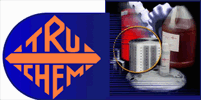

T.C. 771 |
||||||
|
||||||
 |
 |
|
| MISSION STATEMENT | HOME |
|
|
PRIMARY APPLICATIONS T.C. 771 is a liquid acidic compound used for removing shop dirt, oxides, light rust and heat scale, and flux and welding spatter from metals. It is also used for preparing metals for painting and as an acidifying rinse after conversion coating or after alkaline cleaning. CHEMICAL CHARACTERISTICS A combination of phosphoric acid and surfactants.
APPLICATION PROCEDURE For metal cleaning and treating by immersion, use T.C. 771 at 5% to 25% by volume with water at 140° to 160°F followed by rinsing and drying. For metal cleaning and treating of large surfaces by wipe-on methods, use T.C. 771 at 10% to 50% with water at room temperature. Apply with cloths or brushes. Allow to soak for a few minutes followed by rinsing and wiping dry. As a final acidifying rinse after conversion coating or alkaline cleaning, use T.C. 771 to adjust rinse to a pH of 3.5. For milkstone removal, T.C. 771 is used at 1 to 4 pints to 60 gallons of water at 140°F. Soak or circulate for 30 minutes or more followed by neutralizing and rinsing. PERFORMANCE DATA T.C. 771 meets the following U.S. Government Specifications: TT-C-490, Method VI; MIL-C-490 A, Grade II, Type 4 and MIL-M-10578B, Type V. NOTES ON USE Normal precautions for handling acid type materials should be observed in using T.C. 771. T.C. 771 is acceptable for use as recommended in all food plants in line with the requirements of the Food and Drug Administration and the Meat and Poultry Inspection Divisions of the Department of Agriculture. When used in a tank for treating steel, a solution of T.C. 771 may be considered at the point of exhaustion when the ferrous phosphate level approaches 1% (0.36% as iron). Beyond this point, white deposits may form on the work surface. Tanks for T.C. 771 may be made of ceramic, wood, acid-proof brick, Karbate, rubber, lead-coated steel, or stainless steels 304ELC, 316ELC or 347. Heating coils may be made of impervious carbon or graphite such as Karbate Nos. 12 or 22 and Norcordal, lead or stainless steels 304ELC, 316ELC or 347. DISPOSAL If required by local regulations, neutralize to a pH of 8 - 9 with soda ash or spent alkaline solutions available. Allow to settle. Siphon off liquid, or pour slowly into sewer while diluting. Discard sludge. PACKAGING T.C. 771 is packaged in non-returnable containers as follows:
SHIPMENT T.C. 771 may be shipped by any common carrier. Freight Classification is "Cleaning Compound, NOIBN, Liquid." STORAGE While freezing will not affect T.C. 771, for convenience of use it is advisable to store indoors or at moderate temperature.
|